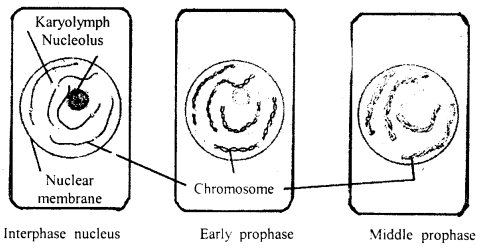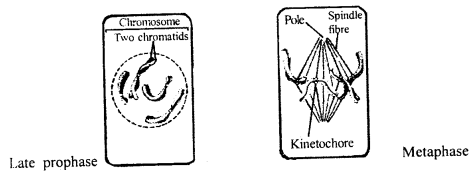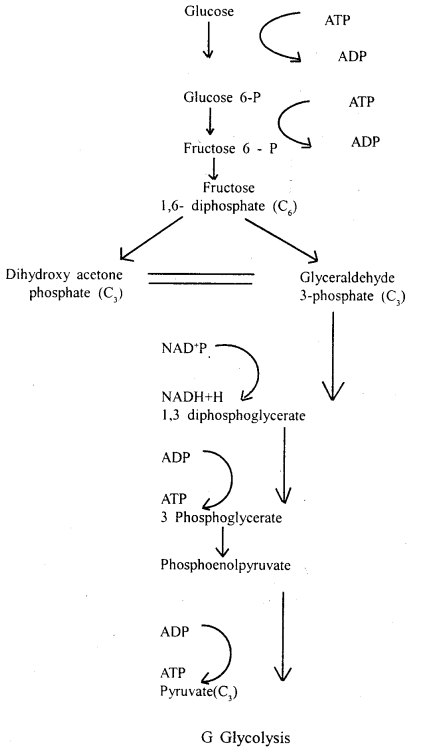Here we are providing Class 11 Biology Important Extra Questions and Answers Chapter 10 Cell Cycle and Cell Division. Important Questions for Class 11 Biology are the best resource for students which helps in Class 11 board exams.
Class 11 Biology Chapter 10 Important Extra Questions Cell Cycle and Cell Division
Cell Cycle and Cell Division Important Extra Questions Very Short Answer Type
Question 1.
Who first described meiosis?
Answer:
Strasburger,
Question 2.
What is a genome?
Answer:
It is a full set of DNA instructions or a single set of chromosomes in a cell.
Question 3.
What is meant by the non-disjunction of chromosomes?
Answer:
Non-disjunction means failure in the separation of homologous chromosomes during anaphase.
Question 4.
Why is mitosis an equational division?
Answer:
Mitosis is an equational division because the daughter cells get the same number of chromosomes from the parent.
Question 5.
What is crossing over?
Answer:
The exchange of segments of chromatids of homologous chromosomes during meiosis is called crossing over.
Question 6.
Why is meiosis a reductional division?
Answer:
Meiosis is a reductional division because it reduces the number of chromosomes from diploid number to haploid number in the daughter cells.
Question 7.
What are the two successive divisions in meiosis?
Answer:
The first division is reductional followed by the second equational di¬vision.
Question 8.
Name the two phases of the cell cycle of a somatic cell.
Answer:
- Interphase and
- M-phase or mitotic phase
Question 9.
During which part of interphase active synthesis of RNA and proteins take place.
Answer:
G. phase.
Question 10.
What amount of DNA is present in the cell during the G2 phase?
Answer:
Double the amount of DNA present in the original diploid cell.
Question 11.
What is a kinetochore?
Answer:
A part of the chromosome for the attachment of chromosomal fibers.
Question 12.
Define Eumitosis.
Answer:
Chromosomes are attached to the spindle by their centromere and this type of mitosis is called Eumitosis.
Question 13.
Who gave the term mitosis?
Answer:
W. Flemming.
Question 14.
How many mitotic divisions will be required to produce 128 daughter cells from a single cell?
Answer:
127.
Question 15.
What is the Gj phase of the interphase?
Answer:
It is the first period of growth of the neatly formed undivided cells, during which the cell synthesizes a lot of RNA and proteins.
Cell Cycle and Cell Division Important Extra Questions Short Answer Type
Question 1.
Define cell cycles.
Answer:
The cell cycle is the sequence of events that occur between the formation of a cell and its division into daughter cells.
Question 2.
What do you understand by homologous chromosomes?
Answer:
Homologous chromosomes are pairs of chromosomes that have similar characteristics. They show pairing during meiosis. One chromosome in each pair is inherited from the father and the other one from the mother.
Question 3.
Why is mitosis an equational division?
Answer:
Mitosis is an equational division because the daughter cells have the same number of chromosomes and an equal amount of cytoplasm.
Question 4.
Why is meiosis necessary in sexually reproducing organisms?
Answer:
Meiosis is necessary for sexually reproducing organisms because
- It maintains the number of chromosomes constant in generation as meiosis is reductional division.
- It causes variations among the progeny because crossing over takes place during meiosis. This variation is important for evolution.
Question 5.
What is the importance of mitosis?
Answer:
Mitosis is important because
- It maintains genetic stability through generations.
- It helps in the growth of multicellular organisms.
- Many plants and animals multiply by mitosis i.e., asexual repro-duction to regenerate the whole organism.
- It helps to regenerate lost parts of an animal’s body.
- It helps in the regeneration of new cells in place of dead and worn-out cells.
Question 6.
What are homologous chromosomes? What happens to homologs during meiosis?
Answer:
Each diploid nucleus has pairs of similar chromosomes called homologous chromosomes. The two homologous chromosomes each derived from one parent during sexual reproduction come together and form pairs during the zygonema of meiosis I. Individuals of a pair are similar in length and in the position of their centromere.
Question 7.
What is the significance of meiosis?
Answer:
Significance of meiosis:
- Sexual reproduction: Maintains a number of chromosomes constant. Characteristic of a species from generation to generation.
- Genetic variation: Through crossing over, it produces variations of genetic characters of the progeny essential for evolution.
Question 8.
What do you mean by cell reproduction?
Answer:
Cell reproduction: Reproduction is an essential phenomenon in the continuity of life. New cells arise by the division of the pre-existing cells. It was proposed by Rudolf Virchow.
Reproduction is of two types:
- sexual and
- asexual reproduction.
The growth and development of the living being are dependent on the division of cells. The single-celled zygotes by means of cell division develop into an adult having a large number of cells.
Question 9.
What is P-oxidation?
Answer:
Fats are broken down into glycerol and fatty acids during digestion. Glycerol enters the glycolytic pathway at the triose phosphate stage. Fatty acids undergo β oxidation by which two-carbon fragments of acetyl A are split off at a time from the fatty acid chain so that the long fatty acid molecule is shortened by two carbon-carbon atoms at a time. This ultimately results in incomplete oxidation of fatty acids.
Question 10.
Distinguish between Anaphase of mitosis and Anaphase of meiosis I.
Answer:
| Anaphase of mitosis | Anaphase of Meiosis I |
| (i) Centromeres divide into two | (i) Centromeres do not separate the chromosomes. |
| (ii) Chromatids separate and move towards the opposite direction | (ii) Half number of chromosomes move towards opposite poles. |
| (iii) Separated chromatids are identical. | (iii) Separated chromosomes are homologous. |
Question 11.
Distinguish between combustion and respiration
Answer:
| Combustion | Respiration |
| (i) It is a non-living process. | (i) It is a biological process, taking place in cells of living organisms. |
| (ii) It oxidizes the substrate releasing the entire energy at once. | (ii) It brings about oxidation of organic compounds releasing energy stepwise. |
| (iii) The energy released is in the form of heat and sometimes partly as light. | (iii) The chemical energy is either made available to the cell or stored in it as ATR |
| (iv) Heat is generated in large amounts. | (iv) The heat is generated in small amounts and does not harm the cell. |
Question 12.
Distinguish between mitosis and meiosis.
Answer:
| Mitosis | Meiosis |
| 1. It takes place in somatic or vegetative cells. | 1. It takes place in gametic or reproductive cells. |
| 2. Completes in one sequence or phase. | 2. Completes in two sequences or phases. |
| 3. Form two daughter cells that are diploid. | 3. Form four haploid daughter cells. |
| 4. Prophase is short and completes in one step. | 4. Prophase I is long and complicated. It completes in five steps. |
| 5. Crossing oyer does not take place. | 5. Crossing over takes place during prophase. |
| 6. Daughter cells are identical to each other and the parent cells. | 6. Daughter cells are not identical to each other and the parent cells show variations. |
Cell Cycle and Cell Division Important Extra Questions Long Answer Type
Question 1.
Describe the changes that take place during the prophase and metaphase of mitosis.
Answer:
Following changes take place during prophase


- Chromosomes become short and thick and sister chromatids are held at the centromere.
- Nucleus and nuclear envelope disappear.
- In animal cells, centrioles move to opposite poles.
- Chromosomes begin to move towards the equatorial plane.
Following changes take place in metaphase:
- Chromosomes lie on the equatorial plate.
- Chromatids become attached by spindle fibers.
- Maximum condensation of chromosomes takes place.
Question 2.
Explain the main steps in aerobic glycolysis.
Answer:
Glycolysis is the breakdown of glucose to pyruvic acid, which includes the following:
(a) Phosphorylation: Transfer of phosphate from ATP to glucose to form glucose – 6 phosphate. One molecule of ATP is consumed enzyme, hexokinase is present.
(b) Isomerisation: There is internal molecular rearrangement to form fructose 6 phosphates. The enzyme is hexose phosphate isomerase.
(c) Second phosphorylation: The fructose – 6-phosphate undergoes phosphorylation to form fructose 1,6 diphosphate. One molecule of ATP is consumed. The enzyme is phosphofructokinase.
(d) Triose phosphates are 3-phosphoglyceraldehyde (PGAL) and dihydroxyacetone phosphate (DHAP). The enzyme phosphorize isomerase maintains the two isomers in equilibrium.
(e) Phosphorylation and oxidative dehydrogenation: PGAL under¬goes simultaneous phosphorylation and oxidative dehydrogenation to form 1,3 diphosphoglyceric acid.
(f) ATP generation: 1,3 diphosphoglyceric acid transfers its phosphate with a high energy bond to ADP to form ATP and 3-phosphoric acid. One molecule of ATP is produced from one triose molecule.
One enzyme is phosphoglyceric kinase Glucose

Question 3.
How cytokinesis is different in an animal and a plant cell?
Answer:
Cytokinesis in plant and animal cells: The separation of daughter nuclei and cytokinesis or cell cleavage maybe two different processes. The first visible changes consist of an appearance of dense material around the microtubules at the equator of the spindle at either mid or late phase then although spindle the fibre tends to disorganize and disappear during telophase, they usually persist and may even increase in number at the equator, frequently intermingled with a row of vesicles and the dense material.
The entire structure is called the midbody. Simultaneously there is a depression on the cell surface a kind of constriction that deepens gradually until reaching the midbody with the completion of the furrowing, the separation of cells is concluded.
The phragmoplast begins to form in the mid anaphase of plant cells. Under the electron microscope, it is possible to observe that the vesicles are of dense material applied together to their surface. The vesicles are derived from Golgi complexes which are found in the regions adjacent to phrag¬moplast which migrate to the equatorial region to be clustered around the microtubules.
Although phragmoplast is initially found as a ring on the periphery of the cell, with time it grows centripetally by the addition of microtubules and partition until it extends across the entire equatorial plane. The vesicles increase in size and just until the two cells are separated by a fairly continuous plasma membrane.
All this time the phragmoplast has been transformed into, cell plate. Thin cytoplasmic connection is plasmoids- data transverse the cell plate and remain in place for communication between the adjacent daughter cells.
The formation of the cell plate also leads to the synthesis of the cell wall. The Golgi-vesicles in phragmoplast is already filled with secretory material consisting mainly of the pectin. The fusion of vesicles results in the combining of the pectin in the extracellular space between the two daughter cells thereby forming the main body of the periphery cell wall.